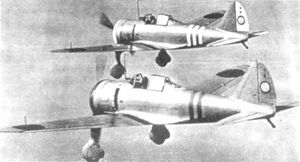The Nakajima Type 97 Ki-27 (Allied code name Nate) was the first single seat low wing monoplane fighter used by the Japanese Imperial Army Air Force.
History[]
Development[]
In June 1935, the Koku Hombu framed a requirement for an advanced fighter, resulting in the submission of designs from Kawasaki, Mitsubishi and Nakajima. The last of these was a company funded project designated PE. This was an all metal stressed skin canteliver monoplane, designed by the team headed by Yasushi Koyama, and completed in July 1936, with the first of two essentially similar prototypes, produced as Ki-27s, first taking to the air on 15th October.[1]
Comparative trials with the other competitors, the Kawasaki Ki-28 and Mitsubishi Ki-33, resulted in an order for 10 pre series Ki-27s for service evaluation.[N 1]
Nakajima were so confident in the Ki-27 that they had already started to make preparations for production at their new plant at Ota when, in late December 1937, the type was ordered into series production as the Type 97 Fighter Model Ko (Ki-27-Ko).[3] The production aircraft was fitted with a Kotobuki Ha-1-Otsu engine rated at 780 hp at 9,515 ft (2,900 m), and two 7.7 mm Type 89 machine guns. This gave way on the production line to the Ki-27-Otsu, which embodied minor changes. [1]
By December 1940 production had been transferred to Mansyu in Manchuria, where it continued until July 1942,[4] by which time almost 3,400 had been built.[N 2]

A pair of Nakajima Ki-27b fighters, marked with the tail badge of the Akeno Fighter School.[N 3]
Service[]
The Army's eagerness to test the new aircraft in combat led to three of the first examples being dispatched to the 1st Chutai of the 2nd Hiko-Daitai (Air Battalion) based at Yanchow in Northern China, arriving in early April 1938. On 10th April, Captain Tateo Kato, commander of the 1st Chutai, flew his first combat sortie in the new type, claiming on his return to have shot down at least three Polikarpov I-15 aircraft. Five days later Major Tamyia Teranishi, the Daitai commander, flew a Ki-27 alongside a trio of Ki-10 aircraft over Shensi, engaging in a dogfight with 30 I-15s which ended with the Japanese claiming 24 Chinese aircraft. The 2nd Hiko-Daitai was still replacing their Ki-10s with Ki-27s when the unit was redesignated the 64th Sentai (Air Regiment), due to a restructuring of the JAAF in August 1938.[3]
By the start of the Pacific War, the type was in service with all but two of the Imperial Army's front line Sentai. Remaining in front line service throughout the first year of the Pacific War, the Ki-27 was then generally replaced by the Nakajima Ki-43 Hayabusa.[5] The Ki-27 also served with the Air Force of Manchukuo (Manchuria).[4]
References[]
Notes[]
- ↑ The Ki-27 was most likely chosen because of it's superior maneuverability[2]
- ↑ There is a slight discrepancy regarding exact numbers. The Illustrated Directory states that total production was 3,399 - 1,379 by Mansyu and the rest by Nakajima,[2] whereas The Complete Book of Fighters puts total production at 3,396 - 2,017 by Nakajima and the rest by Mansyu.[4]
- ↑ Image via IJAAF Photos website. The badge is identified in the caption for this photograph on page 305 of the Illustrated Directory of Fighting Aircraft of World War II[5]
Sources[]
- ↑ 1.0 1.1 Green, William and Gordon Swanborough. Complete Book of Fighters. Salamander Books. 2001. ISBN 1-84065-269-1 Page 425
- ↑ 2.0 2.1 Gunston, Bill. Illustrated Directory of Fighting Aircraft of World War II. Salamander Books. 1988. ISBN 0-86101-390-5 Page 304
- ↑ 3.0 3.1 Guttman, Jon. Fighting Firsts - Fighter Aircraft Combat Debuts fro 1914-1944. Cassell & Co. 2000. ISBN 1 85409 443 2 Page 130
- ↑ 4.0 4.1 4.2 Green, William and Gordon Swanborough. 2001. Page 426
- ↑ 5.0 5.1 Gunston, Bill. Page 305
| |||||||||||||||||
